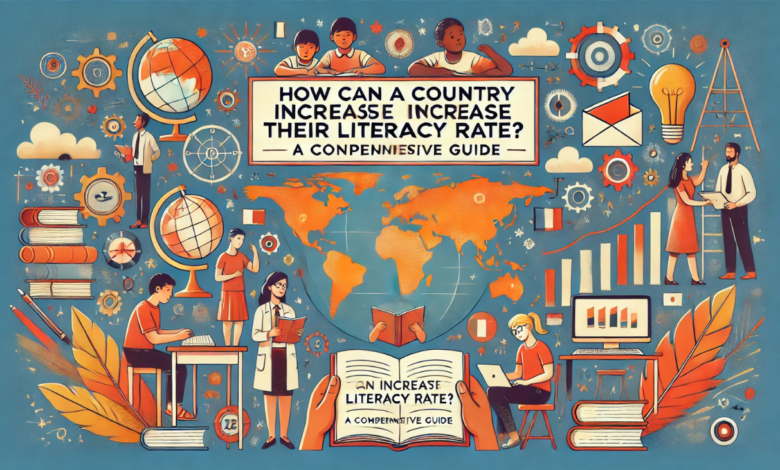How Can a Country Increase Their Literacy Rate? A Comprehensive Guide

In the modern world, literacy is a fundamental building block of a nation’s development. It impacts everything from economic growth to social equality, and improving literacy rates is often seen as one of the most powerful ways to uplift societies. However, many countries still face significant challenges in improving literacy among their populations. So, how can a country increase their literacy rate? There are numerous strategies that, when implemented correctly, can lead to long-term improvements in literacy levels.
Investing in Early Childhood Education
One of the most effective ways a country can increase their literacy rate is by investing heavily in early childhood education. The foundation for literacy is built in the early years, where children are first introduced to reading and writing. Countries that prioritize pre-school education tend to see better literacy rates in the long run. Early education programs ensure that children are not only learning to read but are also acquiring critical thinking skills and vocabulary that will serve them throughout their lives.
Moreover, investing in early childhood education helps reduce the educational gaps between different socioeconomic groups. This ensures that all children, regardless of their background, have a chance to succeed. For instance, nations that have rolled out nationwide pre-kindergarten programs have seen improvements in literacy and overall academic performance.
Improving Teacher Training and Support
Teachers play an integral role in shaping the literacy skills of their students. Countries that invest in improving teacher training often see positive changes in literacy rates. When educators are equipped with the right tools, methods, and continuous support, they are better able to teach literacy effectively.
In addition to initial teacher training, ongoing professional development is equally important. Workshops, training programs, and peer support systems can help teachers stay up-to-date with the latest educational strategies. For example, countries like Finland, known for its outstanding education system, focus heavily on teacher autonomy and continuous professional development to ensure educators are capable of addressing diverse learning needs. Countries that follow a similar approach can see an increase in literacy rates.
Creating Accessible Learning Environments
A key challenge in improving literacy rates is ensuring that education is accessible to everyone. For many people, particularly in rural or impoverished areas, access to education can be limited. A country can increase their literacy rate by building more schools in underserved areas and making sure they are well-equipped to support the learning process.
This includes providing a safe and comfortable environment where students feel encouraged to learn. Furthermore, implementing after-school programs, libraries, and community centers can offer additional learning opportunities. The presence of well-resourced schools and education centers increases the chances of students receiving a solid education, which directly impacts their literacy development.
Utilizing Technology in Education
In the digital age, technology offers powerful tools for improving literacy. From interactive learning platforms to digital books and apps that teach reading and writing, technology can make education more engaging and accessible. For a country to increase their literacy rate, incorporating technology into the education system is essential.
Countries can create digital learning tools tailored to different literacy levels. For instance, AI-powered apps can provide personalized learning experiences for students who may be struggling with literacy, helping them to catch up with their peers. By leveraging technology, countries can reach learners who may not have access to traditional classroom settings, ensuring that no one is left behind.
Promoting Parental Involvement in Education
Parents are often a child’s first teachers, and their involvement in the learning process is crucial. A country can increase their literacy rate by encouraging parents to take an active role in their children’s education. When parents read with their children, help with homework, and encourage curiosity, it significantly boosts literacy development.
Governments can facilitate this by providing resources and programs that educate parents on how to support their children’s literacy at home. Simple actions like reading aloud to young children, discussing stories, and encouraging them to write can make a significant difference. Furthermore, parental involvement helps to instill a love of learning and reading, which contributes to improved literacy rates across generations.
Fostering a Love of Reading
One of the most effective ways a country can increase their literacy rate is by fostering a culture of reading. When reading is seen as an enjoyable and valuable activity, individuals are more likely to engage with it outside of the classroom. Governments can help promote literacy by making books and reading materials widely available.
Public libraries, book fairs, and reading campaigns can all play a role in encouraging people to read. Countries can create initiatives where books are distributed to children in schools, rural communities, and even prisons, as literacy improvement is important for all ages. When reading becomes a widespread and celebrated activity, literacy rates tend to improve across the board.
Addressing Socioeconomic Barriers
Economic inequality is one of the biggest obstacles to increasing literacy rates. In many countries, children from low-income families are less likely to have access to quality education, books, or even a quiet place to study. To increase literacy rates, governments must address these socioeconomic barriers and ensure that all children, regardless of their economic background, have equal access to education.
This could include offering free school meals, providing textbooks and school supplies to those who can’t afford them, or offering financial support to families who may struggle with the costs of education. By breaking down these financial barriers, more children can stay in school, get the education they deserve, and increase their chances of achieving high literacy levels.
Adult Literacy Programs
While early education is crucial, improving literacy rates doesn’t stop with children. Many adults worldwide still struggle with basic literacy skills. Countries can increase their literacy rate by offering adult education programs that provide essential reading and writing skills. This could include evening classes, online courses, or workplace training programs designed to help adults gain the literacy skills they need to succeed.
By investing in adult literacy, countries can create more opportunities for economic growth and social mobility, while also ensuring that older generations are not left behind in the digital age.
FAQ: How Can a Country Increase Their Literacy Rate?
What is the most effective way to improve literacy rates in a country?
The most effective way is to invest in early childhood education, ensuring that children have a strong foundation in reading and writing. Additionally, improving teacher training and support, along with promoting a love of reading, can significantly increase literacy rates.
How can technology help increase literacy rates?
Technology offers digital tools, apps, and online learning platforms that can make education more engaging and accessible, helping students develop literacy skills at their own pace.
How can a country address socioeconomic barriers to education?
Governments can provide financial support, such as free school meals and school supplies, to ensure that children from low-income families have the resources they need to succeed in their education.
How important is parental involvement in increasing literacy rates?
Parental involvement is critical. When parents actively engage with their children’s education, such as reading with them and encouraging learning, it significantly boosts literacy development.
Conclusion
Increasing literacy rates is a complex challenge that requires a combination of strategies. From investing in early childhood education to utilizing technology and addressing socioeconomic barriers, there are numerous ways a country can increase their literacy rate. However, the key is to create an inclusive and supportive environment where all citizens, regardless of age or background, have the opportunity to develop essential literacy skills. By implementing these strategies, countries can pave the way for a more educated, prosperous, and equitable future.



